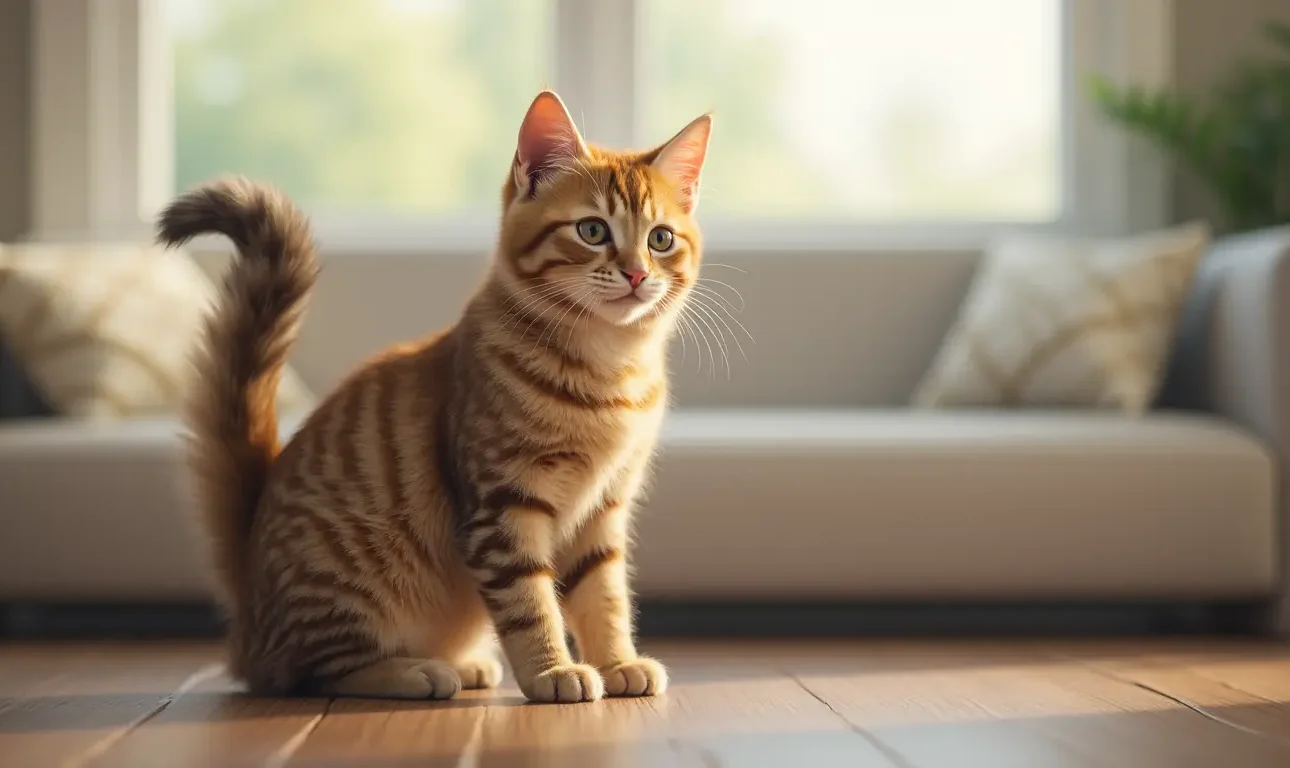Cats are known for their mysterious and often unpredictable behavior, making them both fascinating and sometimes puzzling companions. One of the most important ways cats communicate is through their body language, particularly their tails. While dogs might be more obvious in their tail expressions, cats are a bit more subtle, using tail movements to convey a wide range of emotions and messages. Understanding these signals is crucial for every cat owner, as it helps build a stronger bond and ensures we can respond to their needs or moods appropriately. In this post, we’ll decode what different tail movements mean and how you can interpret your cat’s mood based on their tail behavior.
Table of Contents
Understanding the Basics of Cat Tail Communication
Just like humans use facial expressions and body posture to communicate, cats rely heavily on their tails to express a wide variety of emotions. A cat’s tail can reveal everything from excitement and affection to fear and irritation, making it an essential tool for understanding their moods. Unlike dogs, who may wag their tails broadly, cats use much more subtle movements that can be easy to overlook if you’re not paying close attention.
The anatomy of a cat’s tail plays a significant role in both communication and balance. A cat’s tail is made up of many small vertebrae, making it highly flexible and capable of a wide range of movements. This flexibility helps cats maintain balance, especially when climbing or navigating tight spaces. In addition to this physical function, the tail serves as a critical tool for emotional expression. By adjusting their tail position and movement, cats can signal everything from curiosity to aggression. Understanding these cues is key to interpreting your cat’s feelings and responding appropriately.
Different Tail Movements and What They Mean
Cats’ tail movements are incredibly nuanced, with each motion offering insight into their emotions. Here are some of the most common tail behaviors and what they typically indicate:
- Slow, Gentle Wagging:
A slow, gentle wag of the tail often signals contentment or mild curiosity. Your cat may sway its tail back and forth slowly while sitting or observing something, indicating a calm state. This movement usually happens when your cat is relaxed, watching the world around them with interest, but not in a rush to act. It’s often seen when they’re enjoying quiet moments or when exploring new surroundings. - Fast, Rapid Wagging:
When a cat’s tail starts to wag rapidly and briskly, it’s typically a sign of agitation or frustration. This quick, jerky motion can be seen when a cat is feeling irritated, especially if they’re in a situation that’s bothering them—perhaps an unwanted petting or a frustrating attempt to catch a toy. While not as intense as other signals, this tail movement is a clear indicator that your cat isn’t pleased and may need space. - Lashing or Flicking:
A more dramatic and noticeable movement is the tail lashing or flicking back and forth quickly. This often occurs when a cat is experiencing anger, irritation, or heightened alertness. If your cat’s tail flicks or lashes while they are facing something (like another pet or person), it’s a strong warning sign. This movement indicates that the cat feels threatened, agitated, or is preparing to react to something in their environment, so it’s best to approach with caution. - Quivering or Twitching:
When a cat’s tail quivers or twitches rapidly, especially at the tip, it typically signifies excitement or high alertness. You might notice this behavior when a cat is preparing to pounce on a toy, prey, or even during playtime with you. The quick, trembling movement can also indicate a heightened state of excitement, especially during hunting or when your cat is engaged in an intense game. It’s a sign that they are “in the zone” and mentally focused on the activity at hand.
Each of these tail movements provides valuable clues about your cat’s emotional state, and by paying attention to these signals, you can gain a deeper understanding of your feline friend’s mood and needs.
Why Do Cats Wag Their Tails?
A cat’s tail doesn’t wag without reason—certain situations and stimuli often trigger these movements. Understanding when and why a cat’s tail moves can help you better interpret their behavior in different scenarios. Here are some common situations that can trigger tail wagging:
- When Interacting with Other Pets or People:
Tail wagging often occurs when cats are interacting with other animals or humans. In multi-pet households, cats may wag their tails in response to the presence of another cat or dog, signaling a range of emotions from curiosity to irritation. A slow wag can indicate interest or cautiousness, while a fast or flicking wag may point to frustration or a desire to establish boundaries. Similarly, when interacting with people, cats may wag their tails if they’re happy to see you, or conversely, if they feel threatened or overstimulated. - During Playtime, Hunting, or Exploration:
When a cat is playing, hunting, or exploring their environment, their tail can become an active communicator. In these situations, a cat’s tail may twitch, quiver, or wag as they get excited or focused. For instance, when stalking a toy or prey, a twitching tail signals intense concentration. During play, a gentle wag can show engagement, while more dramatic tail movements can happen when they’re gearing up to pounce or engage in a chase. - In Response to Certain Stimuli, Like Sudden Sounds or Changes in the Environment:
Cats are highly sensitive to their surroundings, and their tails can react quickly to changes in their environment. A sudden loud noise, like a door slamming or a vacuum starting, can cause a cat to lash their tail in surprise or agitation. Similarly, unfamiliar or surprising changes—like the arrival of a stranger or a new object in the room—may cause tail wagging or flicking as your cat assesses the new stimulus. These tail movements are often signs of heightened alertness or caution.
By observing the context in which your cat’s tail begins to wag, you can gain a clearer understanding of their emotional response to various situations. Whether it’s a playful moment, an interaction with another animal, or a reaction to a sudden change, your cat’s tail can give you valuable clues about their mood and feelings.
Tail Wagging vs. Dog Tail Wagging: Key Differences
While both cats and dogs use their tails to communicate, the way they express themselves through tail movement can be quite different. Understanding these differences is key for cat owners, as it helps to avoid misinterpretation of your feline’s emotional signals.
- Subtlety vs. Exaggeration:
One of the biggest differences between cat and dog tail wagging is the level of subtlety. Dogs tend to wag their tails in more obvious and exaggerated ways—wide, sweeping motions or fast, energetic wagging are common, often signaling excitement, happiness, or friendliness. In contrast, cats are more reserved with their tail movements. A cat’s tail wag is typically much more subtle and controlled, and it’s usually a response to more specific emotions or situations, such as mild curiosity or irritation. This means cat owners need to pay closer attention to the context and small details of the tail movements to understand their cat’s feelings. - Emotional Range:
Dogs’ wagging tails are often associated with positive emotions. A wagging dog tail usually indicates joy, enthusiasm, or a desire for interaction, especially when accompanied by a relaxed body posture. In contrast, a cat’s tail wag can signal both positive and negative emotions. For example, a cat might wag its tail slowly when content, but a fast, sharp wag could indicate annoyance or frustration. This wider emotional range in cats means their tail behavior requires a bit more interpretation compared to dogs. - Tail Position:
Dogs often hold their tails in a neutral position or wag them to the side in a “friendly” manner when meeting new people or animals. Cats, on the other hand, use their tail position more deliberately to communicate. A cat’s tail might be held high to signal confidence, low or tucked between the legs when frightened, or flicking rapidly when agitated. Understanding these different positions, in combination with wagging, is crucial for interpreting a cat’s overall mood. - Interaction with People and Other Animals:
Dogs typically wag their tails as a sign of approachability, using their tails as an invitation for play or interaction. Cats, however, may wag their tails during interactions to indicate that they are overstimulated or may need space. For example, a cat wagging its tail in response to being petted too much may be signaling a desire for you to stop. In dog behavior, a wagging tail is almost always a signal to continue or engage further.
By recognizing these key differences, cat owners can better understand what their cats are trying to communicate through tail wagging and avoid the confusion that can arise from comparing cat tail movements to those of dogs. Cats are more nuanced in their tail language, so paying attention to context and subtle cues will help ensure a deeper connection with your feline companion.
What Should You Do When Your Cat Wags Their Tail?
Understanding a cat’s tail behavior is essential for interpreting their mood and responding appropriately. Whether your cat is wagging their tail gently or lashing it furiously, the movement provides valuable insight into how they’re feeling. Here are some tips for interpreting these tail signals and how to approach your cat based on their tail behavior:
- Interpreting Tail Signals:
- Slow, Gentle Wagging: If your cat’s tail is wagging slowly and gently, it’s typically a sign of curiosity or contentment. This behavior usually indicates that your cat is relaxed and engaged with their surroundings or an activity. When you see this, it’s usually safe to approach your cat for petting or to continue interacting, as they are not feeling threatened or upset.
- Fast, Rapid Wagging: A tail wagging rapidly can signal agitation or frustration. Your cat might be feeling annoyed or overstimulated, especially if they’ve been petted for too long or are frustrated with a situation, like not catching a toy. In this case, it’s best to give your cat some space and let them calm down before trying to engage further.
- Lashing or Flicking: When a cat’s tail lashes or flicks sharply, this often signals anger, irritation, or alertness. It’s a clear warning that your cat may feel threatened or upset. If you see this behavior, avoid approaching your cat too quickly or trying to interact directly. Instead, give them some space to settle down. The lashing tail is a sign that they may need time to calm or process a situation before they’re ready to engage again.
- Quivering or Twitching: If your cat’s tail is quivering or twitching, especially during play or hunting, it’s a sign of excitement and focus. This behavior shows that your cat is mentally engaged in an activity, and it’s a good time to interact with them—perhaps by continuing a game or offering a new challenge for them to “hunt.”
- How to Approach a Cat Based on Their Tail Behavior:
- Give Space When the Tail is Lashing or Flicking: If you notice your cat’s tail lashing, it’s important to respect their need for space. Avoid attempting to pet them or pick them up in this state, as it can lead to defensive behavior, such as swatting or hissing. Allow them some time to relax and approach them again once the tail calms down.
- Approach Calmly When the Tail is Gently Wagging: If your cat’s tail is moving gently, it usually means they are in a more neutral or happy state. You can approach slowly, speaking softly to avoid startling them. This is often the best time for petting or play, as they are open to interaction.
- Watch for Signs of Overstimulation: Sometimes a cat might wag their tail gently at first, but if the wagging becomes faster or more intense, it may indicate that they’re becoming overstimulated. If you see this shift, it’s wise to stop petting or playing and give your cat a chance to cool off. Cats are known to tolerate petting for a certain amount of time, but once they’ve had enough, they’ll let you know through their tail and body language.
By paying close attention to your cat’s tail movements and learning to read the context in which they occur, you can better understand their moods and needs. Responding accordingly—whether by giving them space or offering more playtime—helps build a trusting relationship and ensures a positive environment for your cat.
Conclusion
Observing your cat’s tail movements is an essential part of understanding their emotional state and overall well-being. Since cats are often more subtle in their communication than dogs, paying attention to the nuances of their tail behavior can help you interpret their feelings, whether they’re feeling content, frustrated, or even playful. A wagging tail is just one of the many ways cats express themselves, and understanding these signals allows you to respond to their needs in a thoughtful, supportive way.
By becoming more aware of your cat’s body language—especially their tail movements—you’ll be able to form a deeper bond and improve your ability to communicate with them. Each wag or flick tells a story, so take the time to observe and understand what your cat is trying to convey. With patience and attentiveness, you can ensure your relationship with your feline companion is built on mutual understanding and trust.
Frequently Asked Questions (FAQ)
1. Why does my cat wag its tail when I’m petting it?
When your cat wags its tail while being petted, it could indicate that they’re becoming overstimulated or frustrated. Cats can have a limit for how much petting they enjoy, and a wagging tail may signal that they need a break. Pay attention to the speed and intensity of the tail wag to determine whether it’s time to stop or give them some space.
2. Does a cat wag its tail when it’s happy?
While cats do wag their tails when content, it’s usually a slow, gentle wag. This indicates curiosity or a relaxed state. However, a fast or sharp wag can signal irritation or discomfort, so it’s important to differentiate between the different types of tail movements to gauge your cat’s mood accurately.
3. How can I tell if my cat is angry based on its tail?
When a cat is angry or upset, its tail will often lash back and forth sharply or flick rapidly. This is a sign that your cat feels threatened or agitated, and it’s best to give them space. If the tail is held stiff or low, it may also indicate that your cat is feeling defensive or uncomfortable.






